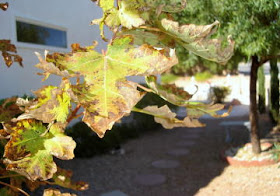Q. I enclosed pictures of a little sapling from North Carolina I bought on line March 2010 several months ago all the leaves turned brown on their edges only. Now the complete tree is burned to a crisp all over. It’s not too much water/or not enough. We live in Sun City Summerlin.
A. Thank you for knowing and remembering what plant bought and its name. This helps me a lot in tracking and learning about this plant before I responded. Autumn Blaze maple was hybridized by an Illinois nursery in the 1980s. In the Midwest or other suitable climates such as the east coast or Pacific Northwest, it will grow to a height of 60 feet and 40 feet wide. It is called Autumn Blaze caused of its splendid red and orange fall colors that can be seen in those parts of the country and I’m sure this is why you selected it.
 This is a case where you have chosen a tree which is just not suitable for our soils or our climate. This particular maple tree is a hybrid between silver maple and red maple, both of which struggle in our alkaline, saline soils and extremely high temperatures. A tree with these two parents in its lineage doesn’t have much of a fighting chance in our desert environment.
This is a case where you have chosen a tree which is just not suitable for our soils or our climate. This particular maple tree is a hybrid between silver maple and red maple, both of which struggle in our alkaline, saline soils and extremely high temperatures. A tree with these two parents in its lineage doesn’t have much of a fighting chance in our desert environment. The pictures you sent me show that it is already struggling here which is evidenced by its scorching leaves. You might be able to give it a fighting chance for a couple of years by heavily amending the soil at planting time with compost and leaching the soil water making sure that the soil drains easily.
You would secondly mulch around the tree with wood mulch, not bark mulch and of course no rock mulch. With adequate amounts of water and organic amendments you might get a tree that is healthy enough to withstand our environment for a few years.
 |
| Readers Autumn Blaze mape tree planted in Las Vegas |
Both parents of this tree are highly susceptible to iron chlorosis and would need treatment for this problem even if you could get it healthy. I’m sorry to give you the bad news but this is a tree which should not be grown here.










